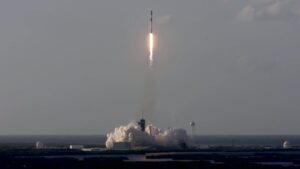Eastern. The rocket’s first stage, making its eighth launch dating back to the Demo-2 commercial mission nearly a year ago, landed on a droneship in the Atlantic.
The rocket’s primary payload, 52 Starlink satellites, separated from the rocket’s upper stage 1 hour and 38 minutes after liftoff. The launch brings the total number of Starlink satellites in orbit to more than 1,600. This was the fourth Falcon 9 launch of Starlink satellites in 17 days, and the ninth Falcon 9 launch of Starlink satellites since the beginning of March.
This launch did not carry the usual complement of 60 Starlink satellites as SpaceX included two rideshare payloads on the rocket that were released from the upper stage about an hour after liftoff. One was the latest in a series of synthetic aperture radar (SAR) imaging satellites for Capella Space. The company launched two other SAR satellites on Transporter-1, a SpaceX Falcon 9 dedicated rideshare mission in January.
The other was Tyvak-0130, a satellite built by Tyvak Nano-Satellite Systems. Neither Tyvak nor SpaceX disclosed details about the satellite, including basic information such as its size and mission. A September 2019 document by NOAA’s Commercial Remote Sensing Regulatory Affairs office described Tyvak-0130 as “an optical spectrum astronomy observation satellite” but did not disclose technical details or if the satellite was built for another customer.
A February 2020 application for a ground station filed with the Federal Communications Commission said that the antenna would be used to communicate with both Tyvak-0130 and Tyvak-0129. The latter is a 6U cubesat launched in December 2019 designed to test what Tyvak called “next-generation spacecraft systems” it planned to use on future spacecraft.
Kate Tice, the host of the SpaceX webcast, said that the company “offers multiple launch opportunities each month for small satellites to ride to space on existing low Earth orbit missions.” However, this is only the second mission of the year to carry rideshare payloads, after Transporter-1 launch in January. Several Falcon 9 launches of Starlink satellites last year carried rideshare payloads for BlackSky and Planet.
SpaceX used the launch webcast to note its May 13 partnership with Google, where SpaceX will collocate ground terminals with Google Cloud data centers. The companies said they would provide new services based on this partnership later this year.
SpaceX also announced it had started beta testing Starlink in parts of the Netherlands. The company has been gradually expanding the beta test program, recently adding Austria and France.



